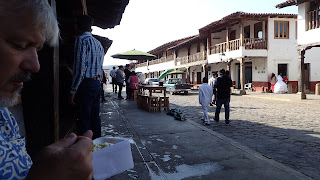Tapalpa, Sayula, Mazamitla, Petate in Jalisco / Michoacan Mexico
To celebrate our 24th anniversary, we decided to make a
brief excursion to the south side of the lake over the (US) Memorial Day
weekend and see some other parts of Mexico. We are currently the middle of the
hottest month here, May, and the destinations we picked were at about 7,000
feet, so slightly cooler. At least at night!
We loaded up Lupita (our 2017 Nissan March) with our maletas (bags), a cooler with rum, Pepsi,
and ice, and a small fan for “protection” – from possibly warm evenings and
also to provide some white noise. We drove towards Jocotepec, then a little
north towards Guadalajara to connect with the toll road “superhighway”
southbound.
The area we were exploring is known for its alpine weather and “Swiss-German” architecture and decorations…for you Pacific Northwesterners out there, think Leavenworth, WA.
 |
| Along the road: Fun art in the (for now) dry lake bed |
The area we were exploring is known for its alpine weather and “Swiss-German” architecture and decorations…for you Pacific Northwesterners out there, think Leavenworth, WA.
Our first stop was Tapalpa, a small town in the mountains. As we left the main road for the winding road into the hills, we saw many roadside stands where people held up small baskets with some greenery falling over the side, next to signs that said hay pitaya! Pitaya is a fruit that grows on certain cacti. The colors are myriad, bold and beautiful. They are full of little black seeds and covered in spines, that must be removed. We watched kids in the Tapalpa plaza peel them and eat them. We were puzzled about the greenery, given that these frutas come from a cactus…a little research says…alfalfa! Hmm. It turned out that this weekend was also the Fiesta de Pitaya. We wondered if they threw the spiny fruit from the backs of pickups!
Tapalpa is a very quaint town, a Pueblo Mágico (Mexican tourism board designation for cultural and
historical sites). It has a red brick church, built in the 1950s after
earthquakes damaged the old adobe and stone church built in 1650 (!). Walking
through the plaza we saw many wide verandas in front of all the businesses.
Building codes (we don’t need no stinking codes!) mandate only red tile roofs
and wooden doors. If Yul Brenner and Steve McQueen came walking down the street
with Colt 45s we would not have been surprised. What a lovely town. Que Mágico!
 On Saturday morning we walked to the plaza in search of breakfast
and ended up with a couple of tamales from a street vendor. We ordered one carne
and one dulce (sweet), but Mark’s dulce
was heard as doce (12), as we figured
out, when they put 12 tamales in a bag! Everyone laughed, no harm, no foul.
After the (2!) tamales we watched about 50 kids walk into the church for
confirmation, the boys in white suits, and girls in beautiful, fancy white
dresses. Did we mention we love Mexico?
On Saturday morning we walked to the plaza in search of breakfast
and ended up with a couple of tamales from a street vendor. We ordered one carne
and one dulce (sweet), but Mark’s dulce
was heard as doce (12), as we figured
out, when they put 12 tamales in a bag! Everyone laughed, no harm, no foul.
After the (2!) tamales we watched about 50 kids walk into the church for
confirmation, the boys in white suits, and girls in beautiful, fancy white
dresses. Did we mention we love Mexico?  |
| Who are you calling a Sisy-phus? |
We also stopped to see some large rock formations called Las Piedrotas.
Next stop was Sayula. The local history book says Sayula was a
relatively important town of commerce until the early 1900s when the railroad
bypassed the town. Sayula is large-ish, but tired. Their plaza is large, but
the gazebo is in total disrepair. Sayula
is known for a famous x-rated ghost story, in which if you take the ghost’s
gold, it can have its way with you. Yikes. Bright spots? There are 2. One is
the Ojeda knife store, where the 4th generation of messerschmidts is
making beautiful, functional, and collectible knives. Sayula is also home to Lugo
Cajeta, maker of delicious cajeta (milk caramel), and owner of bragging rights
for the largest cajeta ever (according to Guinness) – a whopping 3,162 lbs!!! [By
the way, did you know that the Guinness Book of World Records was originally
created as a reference for bars (selling Guinness natch) so patrons could have
something other than futbol to talk about?]
 We ate lunch in Sayula (local specialties…meh) and it turned out that
a senate candidate, Pedro Kumamoto (like the Japanese oyster, great grandfather immigrated here, interesting Japanese Mexican history,) was in the bar,
out of sight of the dining area. This being election season, and he being a
reformer, we would have likely moved on had we known it! It turns out that we
missed the life-size rendition of the aforementioned ghost in that bar, which
we hope had nothing to do with current day politics.
We ate lunch in Sayula (local specialties…meh) and it turned out that
a senate candidate, Pedro Kumamoto (like the Japanese oyster, great grandfather immigrated here, interesting Japanese Mexican history,) was in the bar,
out of sight of the dining area. This being election season, and he being a
reformer, we would have likely moved on had we known it! It turns out that we
missed the life-size rendition of the aforementioned ghost in that bar, which
we hope had nothing to do with current day politics.
On to Mazamitla, a Nahuatyl word which means “place with arrows
for deer.” Which explains why almost all the souvenirs have the head of a venado (deer) on it. Mazamitla is
renowned locally as an amazing and charming town (also a Pueblo Mágico). Its church is very different from most Mexican
churches, and has gingerbread (sort of) features, and painted red and white, as
is most of the town. Turns out it was built in the 1950s. We were lucky to see
a wedding going on, lots of flowers, and mariachis.
This was a weekend, and on Saturday the plaza was literally
overrun with “rich Tapatios” (people from Guadalajara). It was loud and a
little unnerving. Filter feeders were out when the currents of tourists are in
full force. Sunday was quieter, and when we drove out on Monday morning, the
place was close to a ghost town (but not like Sayula!).
 |
| Our cabin |

 |
| Walk to the waterfall! |
One could rent horses for the trip, or for the return there was a John Deere (Juan Venado?) tractor to take you back uphill. Tempting! A family with whom we labored back up the trail offered us a ride out of the neighborhood (uphill)...guess we looked tired? Again, tempting! We felt righteous after the 2 hour hike, so had some nieve de garrafa ice cream, scooped out of a big bucket.
 |
| Maybe if it was an IH? |
 |
| This cute little girl had the best route back up! |
 |
| jugo de zanahoria w/ a view? |
 |
| Yum, bote |
 We returned to San Antonio Tlayacapan via the scenic route, by way
of the tiny village of Petatan. This town is known for flocks of pelicans, from
US and Canada, that spend most of the winter here. Who knew pelicans migrate?
We didn’t. They call them pelicanos
borregones, basically meaning “white like sheep or clouds.”
We returned to San Antonio Tlayacapan via the scenic route, by way
of the tiny village of Petatan. This town is known for flocks of pelicans, from
US and Canada, that spend most of the winter here. Who knew pelicans migrate?
We didn’t. They call them pelicanos
borregones, basically meaning “white like sheep or clouds.” |
| TravelTiki confession |
 We drove on back towards Jocotepec, and made a quick stop in the
small but bustling town of Tizapan El Alto. They had a beautiful church, and the
ubiquitous, rainbow-colored “town name sign,” while there we bought a bag of fruit in
the local tianguis (street market) for 15 pesos (80
cents).
We drove on back towards Jocotepec, and made a quick stop in the
small but bustling town of Tizapan El Alto. They had a beautiful church, and the
ubiquitous, rainbow-colored “town name sign,” while there we bought a bag of fruit in
the local tianguis (street market) for 15 pesos (80
cents).  |
| Saying "your tax dollars at work for you" |
 |
| we don't need no stinkin detours |
And…We returned in time to get celebratory anniversary martinis at
Mama’s!
(29 de mayo de 2018)




















